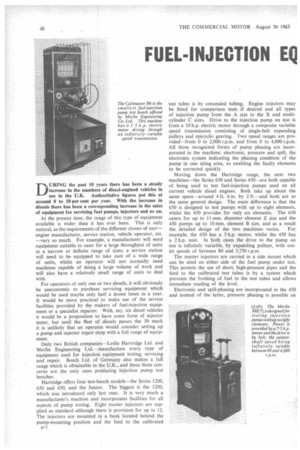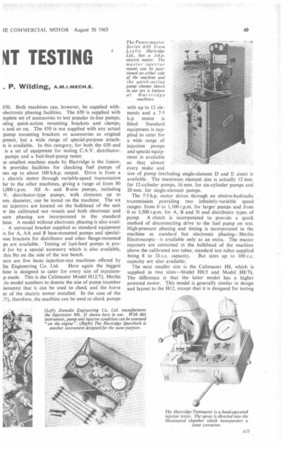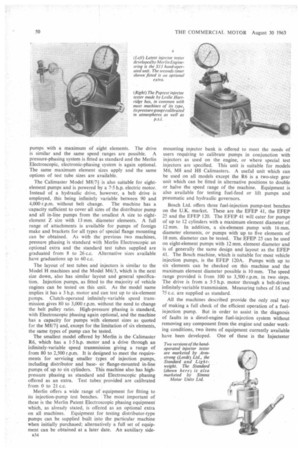FUEL-INJECTION EQ 4T TESTING
Page 50

Page 51

Page 52

Page 53

If you've noticed an error in this article please click here to report it so we can fix it.
. P. Wilding, A.M.I.MECH.E.
DURING the past 10 years there has been a steady increase in the numbers of diesel-engined vehicles in use in the U.K. Authoritative figures put this at around 8 to 10 per cent per year. With the increase in diesels there has been a corresponding increase in the sales of equipment for servicing fuel pumps, injectors and so on.
At the present time, the range of this type of equipment available is wider than it has ever been. This is only natural, as the requirements of the different classes of user— engine manufacturer, service station, vehicle operator, etc. —vary so much. For example, a manufacturer will need equipment suitable to cater for a large throughput of units in a narrow or definite range of sizes; a service station will need to be equipped to take care of a wide range of units, whilst an operator will not normally need machines capable of doing a large volume of work and will also have a relatively small range of units to deal with.
For operators of only one or two diesels, it will obviously be uneconomic to purchase servicing equipment which would be used maybe only half a dozen times in a year. It would be more practical to make use of the service facilities provided by the makers of fuel-injection equipment or a specialist repairer. With, say, six diesel vehicles it would be a proposition to have some form of injector tester, but until the fleet of diesels passes the 50 mark it is unlikely that an operator would consider setting up a pump and injector repair shop with a full range of equipment.
Only two British companies—Leslie Hartridge Ltd. and Merlin Engineering Ltd.—manufacture every type of equipment used for injection equipment testing, servicing and repair. Bosch Ltd. of Germany also makes a full range which is obtainable in the U.K., and these three concerns are the only ones producing injection pump test benches.
Hartridge offers four test-bench models—the Series 1200, 650 and 450, and the Junior. The biggest is the 1200, which was introduced only last year. It is very much a manufacturer's machine and incorporates facilities for all aspects of pump testing. Eight master injectors are supplied as standard although there is provision for up to 12. The injectors are mounted in a bank located behind the pump-mounting position and the feed to the calibrated
13:1,
test tubes is by concealed tubing. Engine injectors may be fitted for comparison tests if desired and all types of injection pump from the A size to the X and multicylinder C sizes. Drive to the injection pump on test is from a 10 h.p. electric motor through a composite variable speed transmission consisting of single-belt expanding pulleys and epicyclic gearing. Two speed ranges are provided—from 0 to 2,000 r.p.m. and from 0 to 4,000 r.p.m. All three recognized forms of pump phasing are incorporated in the machine; electronic, pressure and spill, the electronic system indicating the phasing condition of the pump in one siting area, so enabling the faulty elements to be corrected quickly.
Moving down the Hartridge range, the next two machines—the Series 650 and Series 450—are both capable of being used to test fuel-injection pumps used on all current vehicle diesel engines. Both take up about the same space—around 4 ft. 6 in. by 2 ft.—and both are to the same general design. The main difference is that the 650 is designed to test pumps with up to eight elements, whilst the 450 provides for only six elements. The 650 caters for up to 11 mm. diameter element Z size and the 450 pumps up to 10 mm. element B size, and as a result the detailed design of the two machines varies. For example, the 650 has a 5 h.p. motor, whilst the 450 has a 2 h.p. unit. In both cases the drive to the pump on test is infinitely variable, by expanding pulleys, with outlet speeds of between 80 and 3,750 r.p.m.
The master injectors are carried in a side mount which can be sited on either side of the fuel pump under test. This permits the use of short, high-pressure pipes and the feed to the calibrated test tubes is by a system which prevents the frothing of fuel in the test tubes and allows immediate reading of the level.
Electronic and spill-phasing are incorporated in the 450 and instead of the latter, pressure phasing is possible on 650. Both machines can, however, be supplied withelectronic phasing facilities. The 650 is supplied with rnplete set of accessories to test popular in-line pumps, 'ding quick-action mounting brackets and clamps, s and so on. The 450 is not supplied with any actual pump mounting brackets or accessories as original pment, but a wide range of special-purpose attachts is available. In this category, for both the 650 and is a set of equipment for testing C.A.V. distributorpumps and a fuel-feed-pump tester.
le smallest machine made by Hartridge is the Junior, .11 provides facilities for checking fuel pumps of nes up to about 100 b.h.p. output. Drive is from a ). electric motor through variable-speed transmission lar to the other machines, giving a range of from 80 i,000 r.p.m. All Aand B-size pumps, including V. distributor-type pumps, with elements up to nm. diameter, can be tested on the machine. The six er injectors are located on the bulkhead of the unit w the calibrated test vessels and both electronic and sure phasing are incorporated in the standard hine. A model without electronic phasing is also avail. A universal bracket supplied as standard equipment rs for A, AA and B base-mounted pumps and specialwise brackets for distributor and other flange-mounted ps are available. Testing of fuel-feed pumps is prod for by a special accessory which is also available, this fits on the side of the test bench.
iere are five basic injection-test machines offered by tin Engineering Co. Ltd. Here again the biggest hine is designed to cater for every size of injectionp made. This is the Calimaster Model H12/74. Merlin its model numbers to denote the size of pump (number lements) that it can be used to check and the horse er of the electric motor installed. In the case of the /74, therefore, the machine can be used to check pumps with up to 12 elements and a 7-5 h.p. motor is fitted. Standard equipment is sup plied to cater for a wide range of injection pumps and special equipment is available so that almost , every make and size of pump (excluding single-element D and E sizes) is available. The maximum element size is actually 12 mm. for 12-cylinder pumps. 16 mm. for six-cylinder pumps and 20 mm. for single-element pumps.
The 7-5 h.p. motor drives through an electro-hydraulic transmission providing two infinitely-variable speed ranges: from 0 to 1,100 r.p.m. for larger pumps and from 0 to 3,500 r.p.m. for A, B and N and distributor types of pump. A clutch is incorporated to provide a quick method of disconnecting drive to the fuel pump on test. High-pressure phasing and timing is incorporated in the machine as standard but electronic phasing,--Merlin Electroscopic—is available only as an extra. The master injectors are contained in the bulkhead of the machine above the calibrated test tubes, standard test tubes supplied being 8 to 26 c.c. capacity. But sizes up to 100 c.c. capacity are also available.
The next smaller size is the Calimaster H8, which is supplied in two sizes—Model H8/5 and Model H8(74.. The difference is that the latter model has a higher powered motor. This model is generally similar in design and layout to the 1112, except that it is designed for testing
pumps with a maximum of eight elements. The drive is similar and the same speed ranges are possible. A pressure-phasing system is fitted as standard and the Merlin Electroscopic, electronic-phasing system is again optional. The same maximum element sizes apply and the same options of test tube sizes are available.
The Calimaster Model M8/71 is also suitable for eightelement pumps and is powered by a 7.5 h.p. electric motor. Instead of a hydraulic drive, however, a belt drive is employed, this being infinitely variable between 90 and 4,000 r.p.m. without belt change. The machine has a 'capacity sufficient to cover all sizes of the distributor pump and all in-line pumps from the smallest A size to eightelement Z size with 13 mm. diameter elements. A full range of attachments is available for pumps of foreign make and brackets for all types of special flange mounting can be obtained. As with the previous two machines, pressure phasing is standard with Merlin Electroscopic an optional extra and the standard test tubes supplied are graduated from 8 to 26 c.c. Alternative sizes available have graduations up to 60 c.c.
The layout of test tubes and injectors is similar to the Model H machines and the Model M6/3, which is the next size down, also has similar layout and general specification. Injection pumps, as fitted to the majority of vehicle engines can be tested on this unit. As the model name implies it has a 3 h.p. motor and can test up to six-element pumps. Clutch-operated infinitely-variable speed transmission gives 80 to 3,000 r.p.m. without the need to change the belt pulley ratio. High-pressure phasing is standard, with Electroscopic Phasing again optional, and the machine has a capacity for pumps with element sizes as quoted for the M8/71 and, except for the limitation of six elements, the same types of pump can be tested.
The smallest model offered by Merlin is the Calimaster R6, which has a 1-5 h.p. motor and a drive through an infinitely-variable speed transmission giving a range of from 80 to 2,500 r.p.m. It is designed to meet the requirements for servicing smaller types of injection pumps, including distributor and baseor flange-mounted in-line pumps of up to six cylinders. This machine also has highpressure phasing as standard and Electroscopic phasing offered as an extra. Test tubes provided are calibrated from 0 to 21 c.c.
Merlin offers a wide range of equipment for fitting to its injection-pump test benches. The most important of these is the Merlin Patent Electroscopic phasing equipment which, as already stated, is offered as an optional extra on all machines. Equipment for testing distributor-type pumps can be supplied built into the particular machine when initially purchased; alternatively a full set of equipment can be obtained at a later date. An auxiliary side a34 mounting injector bank is offered to meet the needs of users requiring to calibrate pumps in conjunction with injectors as used on the engine, or where special test injectors are specified. This unit is suitable for models M6, M8 and H8 Calimasters. A useful unit which can be used on all models except the R6 is a two-step gear unit which can be fitted in alternative positions to double or halve the speed range of the machine. Equipment is also available for testing fuel-feed or lift pumps and pneumatic and hydraulic governors.
Bosch Ltd. offers three fuel-injection pump-test benches on the U.K. market. These are the EFEP 41, the EFEP 25 and the EFEP 120. The EFEP 41 will cater for pumps of up to 12 cylinders with a maximum element diameter of 12 mm. In addition, a six-element pump with 16 mm. diameter elements, or pumps with up to five elements of 18 mm. diameter can be tested. The EFEP. 25 can be used on eight-element pumps with 12 mm. element diameter and is of generally the same design and layout as the EFEP 41. The Bosch machine, which is suitable for most vehicle injection pumps, is the EFEP 120A. Pumps with up to six elements can be checked on this machine and the maximum element diameter possible is 10 mm. The speed range provided is from 100 to 3,500 r.p.m. in two steps. The drive is from a 3-5 h.p. motor through a belt-driven infinitely-variable transmission. Measuring tubes of 16 and 75 c.c. are supplied as standard.
All the machines described provide the only real way of making a full check of the efficient operation of a fuelinjection pump. But in order to assist in the diagnosis of faults in a diesel-engine fuel-injection system without removing any component from the engine and under working conditions, two items of equipment currently available have been developed. One of these is the Injectester
. II, manufactured by Dunedin Engineering Co. Ltd.
s instrument is inserted into the high-pressure fuel lines ween the fuel-pump delivery valves and the injectors. engine is run and the readings obtained at each line wared. Worn or dirty delivery valves and their seatare shown up by irregular fluctuations and element ciency and under or over calibration and the amount leak-by can also be determined. The Spotcheck, which introduced by Hartridge last year, operates in a similar
f to give the same type of result and both units, will, addition, give readings showing the injector opening
ssure.
quiprrient to enable more extensive checks of injector Tation—to show opening pressure, spray pattern, leakand so on—are available from a number of concerns, h Merlin, Hartridge and Bosch offering the widest iety. The latest machine to be introduced by Merlin he S.13 hand test pump. Operation of this machine :onventional—a hand pump delivers oil under pressure the injector being tested and the injection pressure can read off a dial graduated to 6,000 p.s.i. and 400 atmos!res. A seconds timer clock can be incorporated on unit and, apart from testing injection pressure, "dry t ", leak-by an the correct spray pattern can be checked.
• re elaborate is the Merlin Diesel Injector and Delivery lye Test Unit, which is available as a cabinet model I) or bench model (S.2). This has a hand-pumping t with a pressure gauge again calibrated to 6,000 p.s.i. 400 atmospheres. Feed is into a spray chamber in which the injector on test is mounted, and this is enclosed by a Perspex hinged lid. The same tests as on the S.13 pump can be carried out with the advantage that the spray is 3ped and extracted by a built-in fan and the interior of spray chamber is illuminated.
itill more elaborate is the Merlin Automatic Dual Conl Injector Tester. This is housed in a cabinet similar the Si test unit and incorporates an 0.25 h.p. motor
d in conjunction with a single-element pump and cam designed to produce an equivalent four-stroke engine ed of 25 to 30 r.p.m. Injectors can be tested by hand seat tightness, back leak, release pressure and atornizai, characteristics, with the motorized section for endur
e testing and observation at less than engine cranking ed.
eslie Hartridge offers a similar range of injector-testing apment. The Poptest is a straightforward hand test np with a pressure gauge calibrated to 5,900 p.s.i. and I atmospheres to ascertain release pressure, and so on. e Hartridge Testmaster is also a hand-operated machine which the injector spray is directed into an illuminated ay chamber, which has a combined centrifuge and fume ractor. Compressed air provides the source of power for the Hartridge Universal Injector Analyser, which tests nozzles by the application of a continuous flow of high-pressure oil, the rate of which can be slowly increased from nil to the demand of the nozzle orifice. The length of the injection period can be controlled so that it is possible to discern the action of the needle throughout the period that it actually lifts and returns to the body seat. The spray is directed into an illuminated compartment with transparent sliding doors and a feature of the machine is a patent Hartridee Prescotime indicator. This incorporates a large-diameter pressure gauge enabling pressure settings, dry seat and back-leakage tests to be made, and surrounding the gauge face is an electric seconds timing clock which can be set to start counts at any desired pressure.
Bosch Ltd. also produces handand power-operated injector testers and also has a device for testing and setting injectors installed in the engine.
A hand-operated, injector-test pump manufactured by Armstrong (Leeds) Ltd. is marketed by the concern in two versions, Standard and Lightweight, The Standard model is also marketed by Simms Motor Units Ltd., and a second hand tester offered by Simms—the Model NT—has the pump unit mounted inside a cylindrical cabinet having a sliding curved Perspex panel in the front.
Injection Maintenance Ltd., of Burnley, is another manufacturer of an injector hand test pump. This is a very neat looking tool in which the fluid tank forms the base. The concern also offers an injector-removal tool, fuelpump camshaft end-float and needle-lift gauges, and designed and manufactures the' Autolap nozzle lapping machine which is marketed by Leslie Hartridge.
Both Hartridge and Merlin Engineering market full ranges of injector reconditioning equipment. Besides the Autolap, which is an automatic two-spindle vertical lapping machine. Hartridge offers, the Rapidlap, which has two horizontal spindles running at different speeds. For re-grinding injector needles and laps there is the Hartridpe Nozzle Reconditioning Machine, which is in effect a small precision grinder.
Merlin's Servicemaster RI and R2 are machines of a similar type designed to perform the same function. The RI is the larger machine and besides its major function of grinding needle seats has facilities for flat lapping and nozzle lapping. The R2 is primarily intended for reconditioning injectors from smaller diesel engines.
Nozzle cleaners, injector-dismantling jigs, fuelinjection pumps, vices and sets of tools specially designed for use on injection equipment servicing, are also available from Merlin and Hartridge. And if any concern wishes its fitters to really understand how to use the machines and tools, both these manufacturers offer full training facilities.




































































































